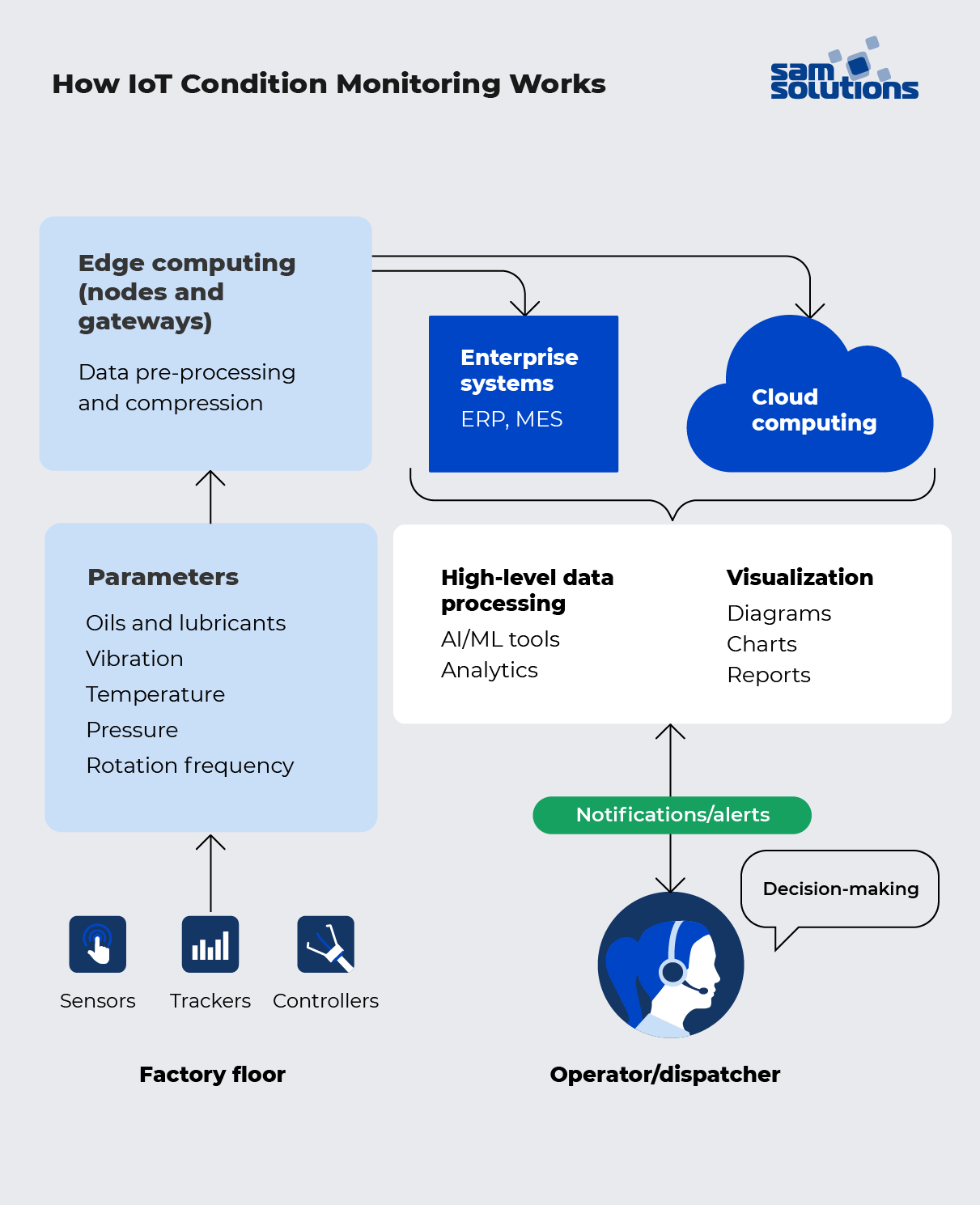To remain competitive in today’s market environment, manufacturing companies must not only produce quality products, but also do this on time so as not to disrupt supply chains and let customers down. Unfortunately, all areas of production face a high risk of equipment failure and unplanned downtime, leading to missed production and delivery times.
However, manufacturers can minimize or totally eliminate unplanned downtime with the help of condition monitoring techniques and IoT technologies. Keep on reading to learn how it works.
Get SaM Solutions’ IoT consulting or development services to deliver a competitive IoT product cost-effectively.
Overview
Sudden breakdowns and equipment downtime arise due to the lack of continuous condition monitoring of machines, which makes it impossible to predict and prevent system failures. Many enterprises still work in the old-fashioned way, making decisions reactively, i.e., when the breakdown has already happened. But there are methods allowing you to act proactively, i.e., take action in advance to prevent such a breakdown.
Proactivity is based on data collection and analysis, and it’s the key principle of condition monitoring and predictive maintenance — advanced approaches that are widely implemented in manufacturing enterprises today. These approaches are similar, since both of them monitor the health of machines and spare parts. However, there are some differences.
Condition monitoring
Condition monitoring requires accurate and continuous input data from a variety of sensors and parameters in real time. This practice includes monitoring a range of equipment parameters (temperature, vibration, rotation, etc.), looking for deviations from predetermined control ranges, and informing operators that it’s time to perform maintenance.
Real-time data in combination with digital twins (virtual prototypes of hardware systems) create a transparent vision of the production process. Through this vision, operators can see deviations in production parameters and prevent emergency situations or mitigate adverse effects.
Predictive maintenance
Predictive maintenance concentrates on the early detection of abnormalities by indirect signs such as sudden spikes or unusual combinations of parameters, even if they are within normal operating ranges.
This is possible due to machine learning algorithms that identify possible scenarios of hardware behavior based on the given performance data. This way, predictive maintenance solutions can forecast which equipment will require maintenance in the near future (e.g., in a month). As a result, companies can effectively schedule maintenance activities and avoid unplanned downtime.
According to various research, manufacturing plants generate large amounts of data daily, but only 10% (or even less) of all available industrial data is used by enterprises to improve operational efficiency. This happens mostly because companies either don’t implement condition monitoring systems at all, or don’t have specialized software solutions for proper analysis of collected data. Such missed opportunities may come at a high price, as each hour of downtime may cost hundreds of thousands of dollars.
How Does IoT Condition Monitoring Work?
Condition monitoring is tightly connected with Internet of Things, because the equipment condition data is collected on is done so via a network of sensors and devices installed on this equipment. The data is then processed either by on-premise enterprise software systems such as ERP and MES, or on specialized cloud software platforms. There is a separate direction — industrial IoT (IIoT) used to enhance processes specifically in plants and factories.

To create a condition monitoring system for manufacturing hardware, you should solve a range of tasks:
- Equip machines on the factory floor with sensors, trackers, controllers, or other monitoring devices
- Set up cloud or on-premise software for collecting, transmitting, and storing data
- Create digital models of equipment operation
- Develop algorithms for data analysis and forecasting
- Set threshold values for parameters and response rules
- Develop reports and data display panels
- Assign responsible employees and train them to work with the system
When all the stages are completed, you’ll get a comprehensive condition monitoring system that will control your manufacturing machines day and night.
Basic hardware parameters for condition monitoring
Condition monitoring systems measure various equipment parameters, which deviations from can indicate coming failures.
- Machine oils and lubricants signalize about overheating or contamination.
- Vibration helps detect wear of spare parts, their misalignment, or imbalance.
- Temperature deviations of mechanical parts may point to wear, lack or absence of lubrication, misaligned spare parts, or foreign objects in machines. Abnormal temperatures in electrical equipment may reflect some leaks, or issues with pressure and current.
- Pressure shows the condition of gas, water, or steam in machines. Pressure deviations warn about leaks or other disruptions of the system’s integrity.
- Rotation frequency is also measured to detect the wear or imbalance of spare parts.
Data stream processing
Internet of Things (IoT) platforms offer ready-made tools and solutions that allow you to quickly create and implement systems for hardware condition monitoring at minimal cost. As a rule, IoT platforms for manufacturing are hardware-agnostic, so you can easily integrate them with various controllers, sensors, and other tracking devices with the appropriate resources.
Data collected by these devices is transmitted to data analysis software tools and then visualized in the form of diagrams, charts, and reports convenient for end users. Such data analysis platforms can be either on-premise or cloud-based.
However, manufacturing machines may generate large data streams with high frequency. And in many cases, it is inefficient and expensive in terms of communication channel bandwidth to transfer raw data directly to the IoT platform.
To solve such issues, there is an edge computing approach, i.e., on-site data processing using gateways and smart sensor nodes. The pre-processed and compressed data is then transferred to a cloud platform or an enterprise system for further analysis.
If the system detects some deviation, it sends a notification/alert message to the responsible employee, who can take instant measures.
How Can IoT Help With Condition Monitoring?
The Internet of Things concept in its essence implies the creation of a network of sensors and trackers installed on various physical objects. Such sensors and trackers are able to collect data, communicate with each other, and transmit data to software platforms for processing and analysis.
There are several reasons why IoT solutions are crucial for condition monitoring of industrial equipment.
Established communication channels
A variety of IoT communication protocols are used to connect hardware machines and ensure their seamless interaction and data transmission. Reliable communication channels are highly important for condition monitoring, as they ensure the timely receiving of information and prompt decision-making.
Remote condition monitoring and management
With IoT technologies, you can monitor and manage various types of equipment remotely. This is essential for certain industries where machinery works in remote terrains, e.g., oil and gas production.
IoT devices eliminate the necessity for maintenance employees to be on-site all the time, as they collect and transmit data on equipment conditions automatically in the online mode. In case of issues, operators can either switch operating modes or stop the equipment remotely, thus preventing failures. This way, companies can significantly reduce maintenance costs because maintenance crews go to the field only when repairs are actually needed.
Cloud computing
IoT offers limitless opportunities for cloud data processing and storage. Taking into account that industrial machines generate tons of data, it’s more cost-efficient and convenient to store this data in the cloud, on remote servers. Moreover, cloud IoT platforms provide enterprise employees and managers with secure access to condition monitoring data from anywhere, which facilitates decision-making.
Machine learning
Modern IoT platforms are equipped with advanced analytics, including AI and machine learning algorithms. This means that collected data can be processed more efficiently and valuable insights on the condition of machinery can be extracted.
Automation
The usage of IoT in condition monitoring results in a high level of automation. Staff employees don’t have to check and test all the machines manually in order to detect malfunctions, since IoT trackers and sensors do it automatically without days off and lunch breaks.
Examples of Condition Monitoring Applications
In fact, all industries that work with some kind of equipment and hardware devices can make use of IoT-based condition monitoring. The following are the most popular fields of application so far.
Renewable energy
As more countries and companies strive to abandon fossil fuels and implement renewable energy solutions, more complicated innovative machinery is put into operation globally. Undoubtedly, equipment for wind, solar, and hydroelectric energy systems require continuous condition monitoring, which can be ensured only with the help of IoT solutions.
Downtime and failures of such systems lead to tremendous economic losses and compromise social spheres that consume energy. To avoid significant accidents, governments and green energy business owners actively invest in IoT condition monitoring systems.
Oil and gas exploration and development
The reliability of equipment (turbines, pumps, compressors, generators, etc.) at oil and gas fields impacts not only the financial health of companies, but also the safety of the environment. Considering that most oil and gas sites are located either offshore or in remote areas with tough weather conditions, using IoT-based condition monitoring is a must for the industry.
Manufacturing
Both discrete manufacturing (the production of distinct items such as automobiles, household appliances, furniture, etc.) and process manufacturing (the production of foodstuff, chemical and biotechnological goods, etc.) depend on the performance of machinery. All kinds of welding, milling, drilling, rolling and other machines should be continuously monitored to avoid the negative impact of some defects on the entire batch of products coming off the assembly line. Hence, plants and factories willingly introduce IoT condition monitoring solutions.
Transportation
The transportation industry strongly depends on the technical and operating condition of vehicles. Any spare part defect or its amortization may cause a road accident, resulting in delivery delays, significant car damages, and even human victims. IoT technologies and condition monitoring are a go-to for transport companies striving to minimize accidents, reduce delays, and lower maintenance costs.
Ready-Made Solutions for Condition Monitoring by STMicroelectronics
With the advancement of modern technologies and a variety of hardware providers on the market, companies don’t need to invent the wheel and develop condition monitoring or predictive maintenance systems from the ground up. Fortunately, there are ready-made hardware and software solutions for these purposes.
A great example is STMicroelectronics, one of the world’s leading semiconductor companies headquartered in Switzerland. They offer a wide range of energy-efficient products and solutions powered by mobile and IoT devices for smart factories and other industries dealing with electronics.
ST’s portfolio for condition monitoring and predictive maintenance includes microcontrollers and microprocessors, sensors and inertial measurement units (IMUs), as well as wired and wireless communication solutions. For instance, you can quickly and easily develop a data logging and anomaly detection solution with the help of the following products by ST:
- STWIN SensorTile — a development kit and reference design based on an ultra-low-power microcontroller and comprising industrial-grade sensors (accelerometer, vibrometer, etc.). Using it, you can create and test IIoT prototypes.
- FP-SNS-DATALOG1 — a comprehensive solution for data collection and storage from any type of sensor.
- FP-AI-NANOEDG1 — a function pack for creating Machine Learning libraries for each specific project and integrating them on physical nodes. Its distinctive feature is that a NanoEdge AI library can learn normal patterns directly on the microcontroller, without any connection to the cloud.
In other words, if you need to build a condition monitoring system for your industrial equipment, you are free to choose from ready-made hardware and software solutions, combine them to meet your project requirements, and benefit from results — simple as that.
Advantages of Condition Monitoring Systems
The key objective of condition monitoring systems is to help companies avoid potential equipment failures and damages. If this objective is achieved, companies enjoy a number of valuable benefits from using such systems.
- Reduced maintenance costs — doing preventive maintenance is cheaper than fixing serious equipment damages and coping with the hidden expenses of downtime. Moreover, manufacturers can also reduce energy costs due to monitoring critical parameters and ensuring the proper operating mode of hardware.
- Maximized productivity — when all the machines work like a clock and the process is not interrupted by technical issues, employees fulfill their tasks on schedule, hence showing consistently good output.
- Longer lifespan of the equipment — timely maintenance and avoidance of significant breakdowns ensured by IoT condition monitoring prolong the service life of machines, eliminating unnecessary expenses.
- Guaranteed operational safety — in many industries such as chemical, nuclear, biological, transport, and others, machinery malfunctions may cause serious environmental disasters, harming people and nearby territories. IoT technologies and condition monitoring systems prevent machinery from causing catastrophes.
A Success Story
SaM Solutions in partnership with Toradex, a provider of embedded computing solutions from Switzerland, developed a prototype of a predictive maintenance system that monitors motor vibration frequency and force to detect abnormalities, signaling failures. The system can be applied to any industrial equipment with electric motors.
This condition monitoring system collects data on the motor performance via a Toradex MPU-6050 sensor and analyzes it with the help of machine learning algorithms written in Python and based on the Amazon Greengrass cloud service and Amazon Lambda function.
The efficiency of prediction results of this prototype turned out to be up to 99%.
Summing Up
Solutions and tools for condition monitoring and predictive maintenance of industrial equipment are being actively developed all over the world, and IoT platforms play a key role in this process. To remain competitive, increase production transparency, and enhance system uptime, industrial enterprises need to implement IoT and condition monitoring technologies.
Transform your business or gain a competitive advantage in your industry with custom IoT software solutions from SaM Solutions.
SaM Solutions has the skill set to design, develop and implement IoT and embedded projects for monitoring the condition of equipment across various industries. Contact us if you want to get a consultation and learn the details about our related projects.



















 The Latest 15 Information Technology Trends in 2024
The Latest 15 Information Technology Trends in 2024 Top 10 Embedded Software Development Tools
Top 10 Embedded Software Development Tools IaaS vs. PaaS vs. SaaS: What’s the Difference?
IaaS vs. PaaS vs. SaaS: What’s the Difference? 10 Examples of Predictive Analytics
10 Examples of Predictive Analytics












 SAP Commerce Cloud (ex.Hybris) and S/4HANA Integration
SAP Commerce Cloud (ex.Hybris) and S/4HANA Integration Java Microservices Architecture: A Comprehensive Guide
Java Microservices Architecture: A Comprehensive Guide Azure Java Development: A Comprehensive Guide
Azure Java Development: A Comprehensive Guide SAP Commerce Cloud Accelerators
SAP Commerce Cloud Accelerators Top Java Technology Trends 2025
Top Java Technology Trends 2025
It’s great that providers, such as STMicroelectronics that you’ve mentioned in the article, offer ready-made solutions for creating condition monitoring systems. This simplifies the development and implementation, making life easier for manufacturers and allowing them to gain all the benefits of smart systems.
Efficient condition monitoring systems are based on IoT devices and machine learning tools for data analysis. In fact, such systems should become a key component of the maintenance process for production machines.
You’ve provided valuable information on ready-made solutions by STMicroelectronics, thanks. It’s helpful for companies that are searching for reliable and efficient condition monitoring hardware and software providers.
I’m interested in embedded solutions for predictive maintenance in manufacturing, since this area has huge potential. Your success story inspires a lot, so I wish you good luck with future projects, and would like to read more about the results.
The health and operating parameters of essential machines in enterprises must be continuously monitored. Human specialists are unable to do this task manually, that’s why the role of sensors, tracking devices, and data analysis tools is growing exponentially.
Condition monitoring is a must for various modern enterprises. It ensures immediate awareness of issues with equipment, so employees can respond promptly. This practice has a major impact in terms of reducing maintenance costs, avoiding unplanned downtime, and making business owners and end users happier.
I guess you are a true professional in IoT and embedded development, as you can explain the details about condition monitoring in such a clear way. Thank you for the blog.
The topic is really interesting and acute, so you are doing a great job covering it. Many companies today run highly complicated equipment, so condition monitoring seems to be the best way to avoid significant expenses on its maintenance, and in general prolong its service life.